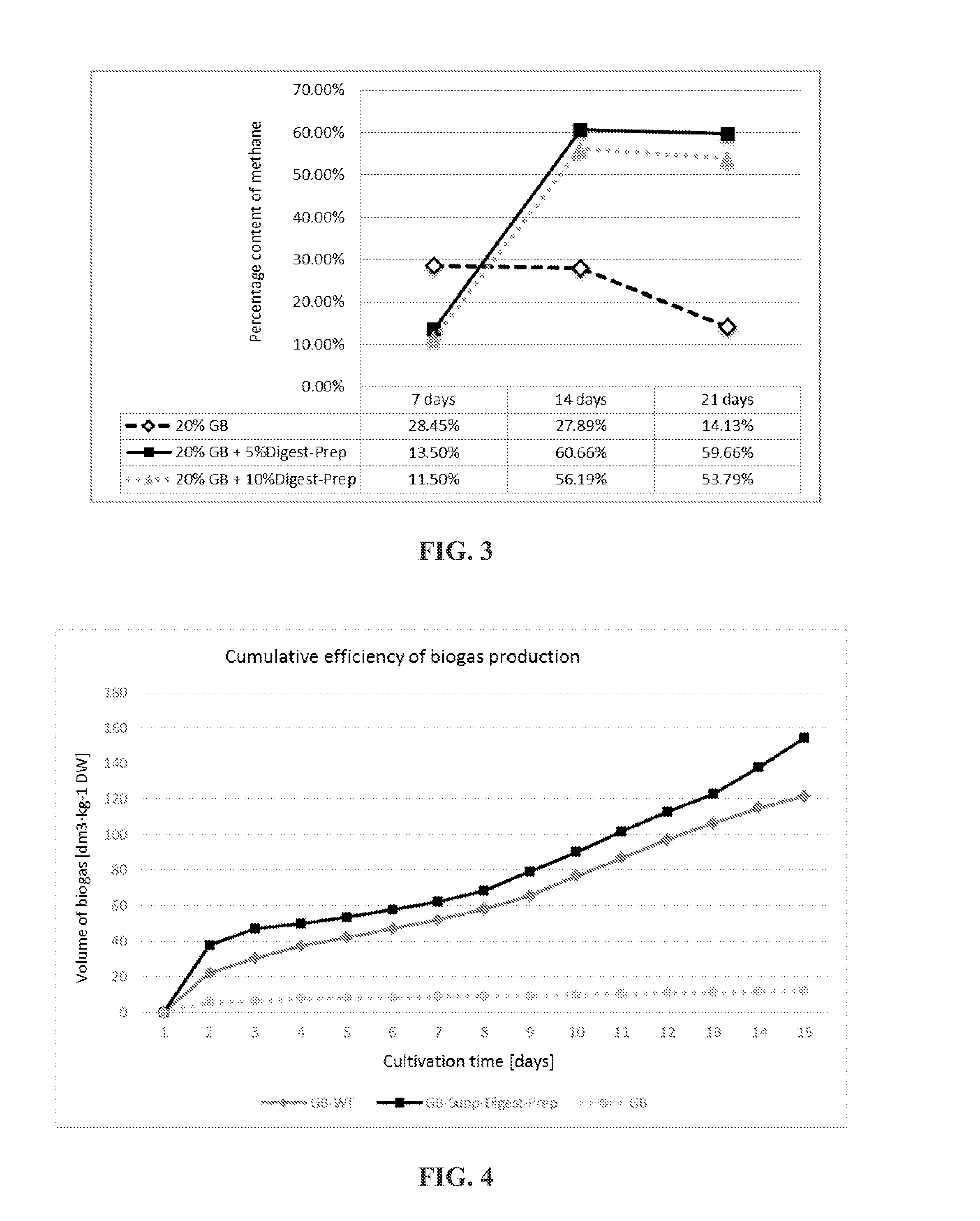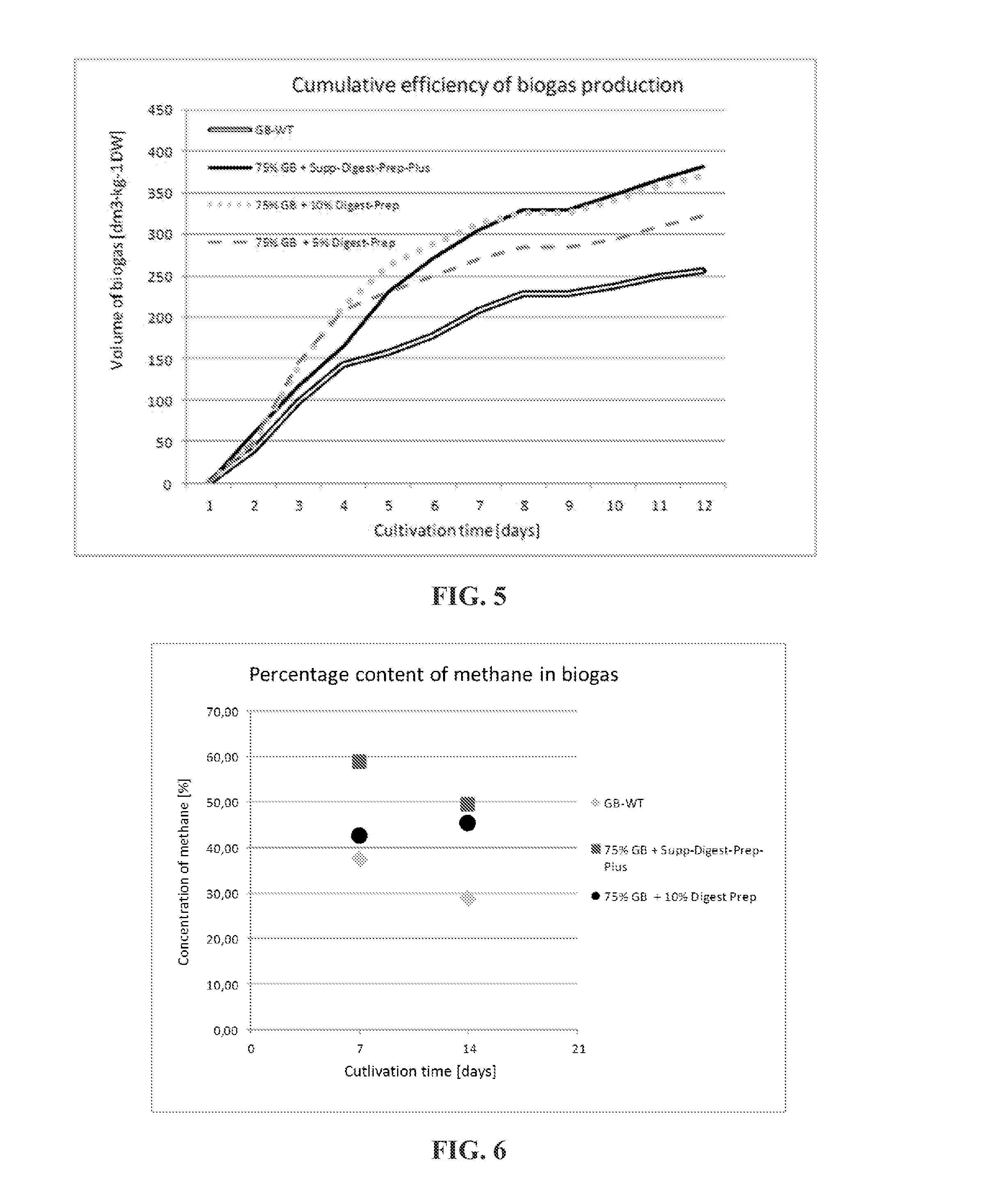Consortium and preparation of microorganisms for catalyzing cellulose hydrolysis, preparation for methane fermentation supplementation, combination preparation, use thereof and method using the same
a technology of catalysis and microorganisms, which is applied in the field of consortium and preparation of microorganisms for catalyzing cellulose hydrolysis, preparation for methane fermentation supplementation, combination preparation, etc., can solve the problems of system overload and deceleration, reduce the efficiency of the fermentation process, and accumulate too many intermediate products
- Summary
- Abstract
- Description
- Claims
- Application Information
AI Technical Summary
Benefits of technology
Problems solved by technology
Method used
Image
Examples
example 1
Selection and Identification of Bacterial Strains with an Increased Hydrolytic Activity of Lignocellulosic Biomass
[0059]Bacteria capable of degrading cellulose were isolated from inoculum samples from: (i) agricultural biogas plant hydrolyser from Miedzyrzec Podlaski, (ii) raw sludge from the wastewater treatment plant Czajka in Warsaw, (iii) slurry and cattle manure from farm households in Niemglowy and Trzebieszow Pierwszy. Selection was performed using the modified minimal medium of the following composition: peptone 5 g / l; yeast extract 5 g / l; NaCl 5 g / l; KH2PO4 1 g / l; MgSO4 0.2 g / l; carboxymethylcellulose (CMC) 10 g / l; pH 7.0 (Bushnell and Haas, 1941). Cultures were carried out in 200 ml of the medium with the addition of 0.5% of dry weight of the initial inoculum, at 30° C., 120 rpm for 72 hours. Subsequently, the culture was passaged onto minimal medium with CMC. After each of the 6 passages made, bacteria were plated on minimal medium with CMC solidified with agar, and incub...
example 2
Determination of the Activity of Extracellular Cellulolytic Enzymes
[0061]In order to show that the selected strains are characterized by a high cellulolytic activity, a detailed, quantitative assay of the activity of cellulolytic enzymes was carried out using the modified method developed by Ghose T. K. (1987). Cellulolytic activity was determined indirectly based on the quantity of reducing sugars (glucose) in the reaction mixture, resulting from the hydrolysis of carboxymethylcellulose by enzymes secreted from the selected microorganisms cultured on minimal medium with CMC. To 0.5 ml of double-diluted culture supernatant an equal volume of 2% solution of carboxymethylcellulose was added, and incubated for 30 minutes at 50° C. After the incubation, 3 ml of 3,5-dinitrosalicylic acid (DNS) were added to the reaction mixture and it was incubated again for 5 minutes in boiling water. Subsequently, the samples were cooled and 20 ml of distilled water were added, and vigorously mixed. Ab...
example 3
Determination of the Optimal Conditions for the Growth of Pure Cultures and the Digest-Prep Consortium
[0065]In order to determine the optimal conditions for the growth for individual strains of bacteria and the consortium, microorganisms were cultured on medium with CMC in different growth conditions (carboxymethylcellulose substrate concentration, temperature, pH).
[0066]To determine the optimum pH, the tested strains of bacteria were passaged onto minimal medium with carboxymethylcellulose, having pH from 4 to 10, respectively. The density of the cultures at the beginning of the experiment was set at approx. 106 cfu / ml. The cultures were incubated for 96 hours at 37° C. The OD600nm value measurements were performed every 24 h.
[0067]In order to determine the optimal growth temperature, the tested strains of bacteria were passaged onto minimal medium with carboxymethylcellulose, having pH of 7. The cultures were incubated for 96 h at: 23° C., 30° C., 37° C., 45° C. The OD600nm value ...
PUM
| Property | Measurement | Unit |
|---|---|---|
| pH | aaaaa | aaaaa |
| wavelength | aaaaa | aaaaa |
| pH | aaaaa | aaaaa |
Abstract
Description
Claims
Application Information
 Login to View More
Login to View More - R&D
- Intellectual Property
- Life Sciences
- Materials
- Tech Scout
- Unparalleled Data Quality
- Higher Quality Content
- 60% Fewer Hallucinations
Browse by: Latest US Patents, China's latest patents, Technical Efficacy Thesaurus, Application Domain, Technology Topic, Popular Technical Reports.
© 2025 PatSnap. All rights reserved.Legal|Privacy policy|Modern Slavery Act Transparency Statement|Sitemap|About US| Contact US: help@patsnap.com



